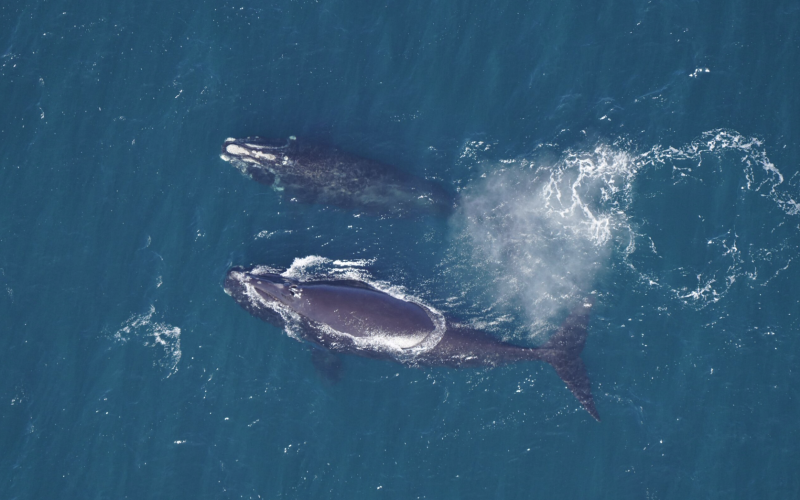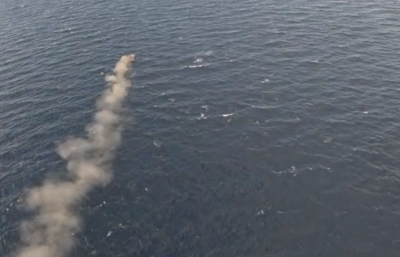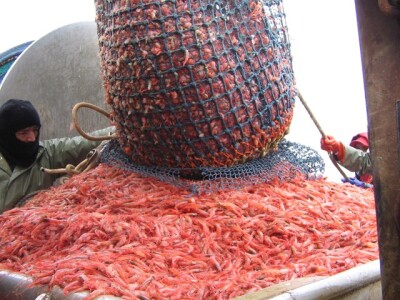The endangered North Atlantic right whale population may have grown slightly with new calves born in 2021-2023. But human activities in the ocean could still be killing as many whales as are born, scientists say in their latest assessment.
In a report released for its annual meeting this week, the North Atlantic Right Whale Consortium updated its estimate for the 2022 whale population at 356 animals, based on 18 calves born in 2021, according to a summary from the New England Aquarium.
“While certainly more encouraging than a continued decline, the ‘flattening’ of the population estimate indicates that human activities are killing as many whales as are being born into the population, creating an untenable burden on the species,” said Heather Pettis, a research scientist in the Anderson Cabot Center for Ocean Life at the New England Aquarium and executive administrator of the North Atlantic Right Whale Consortium.
The aquarium and science partners at the National Oceanic and Atmospheric Administration work together on coordinating surveys of the right whale population – one of the most endangered species on Earth – and NOAA published a detailed technical memo on the latest assessment Oct. 23.
At its meeting in Halifax, Nova Scotia, this week the whale science consortium is reviewing reports on right whale deaths including ship strikes and fishing gear entanglements, the two leading causes of deaths from human interaction.
During 2023, strandings of humpback whales on Mid-Atlantic beaches triggered a news media and political uproar from opponents of offshore wind energy projects, who claimed survey work for the projects could be contributing to the whale deaths.
But meanwhile, there were two documented deaths of right whales: a 20-year-old male struck and killed by a vessel near Virginia Beach, Va., and an orphaned newborn calf found in North Carolina. Whale researchers say more whale deaths probably go undetected, and survivors still live with injuries from vessel hits and entanglements.
“Many of these injuries will likely lead to death, while other injured or sick whales may not be able to reproduce because of their condition. This is an important piece of the right whale puzzle. We can’t just focus on [detected] bodies,” said Philip Hamilton, senior scientist at the Cabot center in the group’s statement issued Monday. “We must also reduce all injuries that harm this species if they are to turn the corner.”
While slightly more optimistic, the new population estimate is unlikely to quell ongoing legal and political battles among whale conservationists and various fishing and maritime groups over how far NOAA must go in reducing the man-made hazards.
Northeast lobster fishermen have won some breathing room after fighting even stricter restrictions they said could effectively shut down the fishery, despite the industry’s efforts to reduce conflicts and reduce the number of traps and vertical lines. Meanwhile, NOAA is pressing on with testing on a trial of on-command, or so-called ropeless gear, that the agency sees as the future for reducing entanglements and saving the fishery.
The other battlefront now in Congress is over NOAA’s proposal to extend 10-knot seasonal management area speed restrictions to smaller vessels between 35 and 65 feet in length. Opponents and their allies in the House of Representatives have worked to block NOAA from imposing new speed limits until better monitoring technology is developed to track right whale movements off the East Coast.
New England Aquarium researchers say they tallied 32 human-caused injuries to right whales in 2023, including six fishing gear entanglements with attached gear, 24 entanglement injuries (with no attached gear), and two vessel strikes.
“We continue to injure and kill these whales at alarming rates, such that they cannot carry out basic biological functions like growth and reproduction. While the absolute population numbers are important, other indicators are discouraging. Until we implement strategies that eliminate injuries and deaths and promote right whale health, this species will continue to struggle,” said Dr. Scott Kraus, chair of the consortium.
Calving numbers continue to lag behind what scientists saw a decade ago, according to the Cabot center.
“Eleven live calves in 2023 is a very modest number and nowhere near the average of 24 per year from the 2000s. It is particularly alarming that more than 40 adult females between the age of 10 and 20 have yet to birth their first calf when the average first calving was 10 years old in previous decades,” Hamilton noted.







